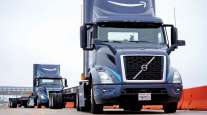Senior Reporter
Medium-Duty Trucks Ready for Battery-Electric Urban Deliveries, NACFE Report Says

Medium-duty commercial battery-electric vehicles are a viable alternative to diesel and gasoline-powered Classes 3-6 trucks in urban settings where the freight haul is less than 100 miles, according to a new guidance report from the North American Council for Freight Efficiency.
“Medium-Duty Electric Trucks: Cost of Ownership” details the factors to consider in selecting medium-duty CBEVs, including the cost-benefit factors for estimating the return on investment. The council’s report noted CBEVs are capable of meeting zero-emissions mandates, which is a primary motivation for fleets considering these trucks.

Roeth
“We have concluded medium-duty CBEVs — electric, not hybrids — are here as a real solution for specific applications,” NACFE Executive Director Mike Roeth said. “We were told by a number of companies that the upfront truck cost is nearing parity between a diesel medium-duty truck and an electric one in some of the shorter duty cycles.”
Development is taking place across the industry, from startups to entrenched companies with decades of history, Roeth added. “Everywhere we go, we see hardware, testing and test results,” he said.
A separate study by UPS Inc. and GreenBiz Group Inc. also found battery-electric medium-duty delivery trucks can be deployed today at the same cost as diesel vehicles.
UPS ranks No. 1 on the Transport Topics Top 100 list of the largest for-hire carriers in North America.
Compared with six months ago, Roeth said he was “surprised and impressed” that the industry has progressed so quickly and that “the collective industry sees a return on investment that makes sense for them to move forward.”
He added, “We don’t see this as a fad but as a real solution for some applications in the early days — and a good one for more of the trucks in these markets going forward.”

A rendering of the UPS electric Class 6 delivery truck, a medium-duty vehicle. (UPS Inc.)
“Medium-duty vehicles with one-shift-per-day operations offer the most straightforward application for battery-electric vehicles; as trucks sit idle for long enough periods of time, they can be charged at cost-effective rates and with fewer infrastructure demands,” Keshav Sondhi, director of fleet engineering and sustainability for PepsiCo Inc., wrote in a testimonial included in the report.
PepsiCo ranks No. 1 on the Transport Topics Top 100 list of the largest private carriers in North America.
Total-cost-of-ownership modeling for battery-electric vehicles involves a number of projections and estimates, according to the report. NACFE identified 20 generally unknown factors that fall into four broad categories: market issues, battery issues, regulatory issues and power issues. To help sort out the relative benefits, NACFE developed a total-cost-of-ownership calculator to compare diesel and gasoline truck investments against comparable battery-electric trucks.
The issue of technician training for CBEVs came up during a conference call NACFE hosted with reporters.
“The original equipment manufacturers that were looking at manufacturing these things, are all talking about having only experts service the high-voltage pieces,” said Rick Mihelic, NACFE’s director of future technologies studies. “It’s a plug-and-play repair type situation. You pull something off and ship it to an expert to repair it and replace it with a core.”
Subsequent NACFE reports this year and in 2019 will focus on charging infrastructure and the cost of ownership of heavy-duty regional-haul and heavy-duty longhaul electric-based tractors.
Roeth said he was not sure how quickly the adoption of medium-duty CBEVs will take place.
“I’m not even sure exactly what duty cycles, business models and fleets will be the early adopters,” he said. “But it’s here. We are interested in helping in continuing the dialogue.”
The report is available for purchase in the resources section of the group’s website.




